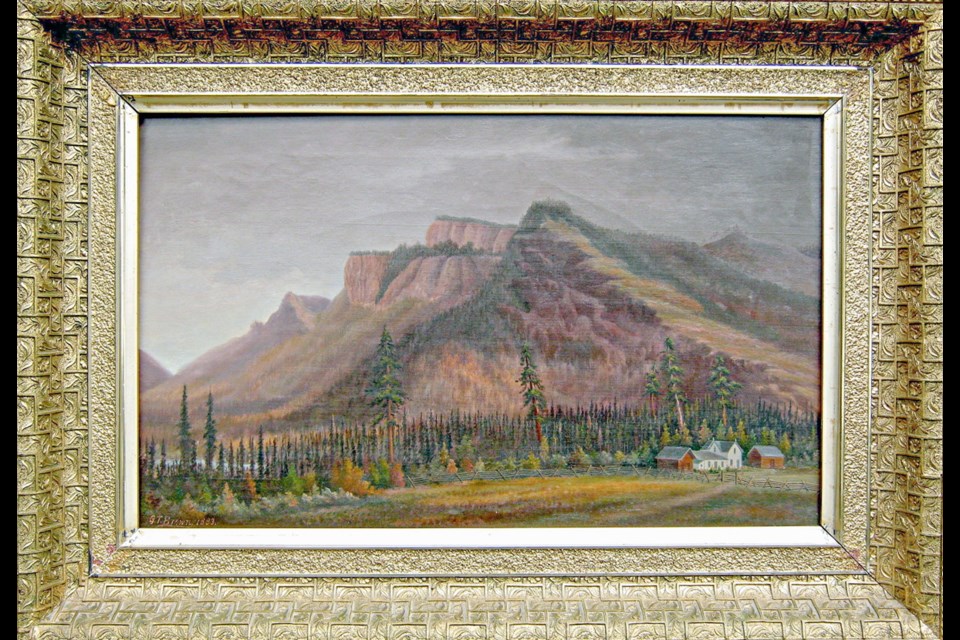The Royal B.C. Museum has purchased an major landscape painting by 19th-century African-American artist Grafton Tyler Brown.
The painting — Giant’s Castle Mountain: A.L. Fortune Farm, Enderby B.C. Oct. 6, 1882 — is considered by University of Victoria history professor John Lutz to be the most important of Brown’s B.C. paintings. The painting, bought for $44,000 from Uno Langmann Fine Art Ltd. in March, shows Alexander Leslie Fortune’s farmstead on the edge of a forest. The agrarian foreground is dwarfed by a looming mountain.
The Royal B.C. Museum holds the greatest number and most significant of Brown’s Canadian works. Giant’s Castle Mountain is considered to be a work of artistic and historical significance to British Columbians. It was painted in Victoria after Brown visited the southern Interior.
“We hope that the painting’s subject matter and history will lead to significant, perhaps challenging, conversations about the history of settlers in B.C., including immigrants like Brown,” said museum chief executive officer Jack Lohman. “It’s a focal point for discussing ethnicity and identity and also allows us to probe the relationship between landscape paintings, nature and the presence of humans.”
Fortune was a major figure in the Okanagan. He was the first white settler in the North Okanagan to pre-empt land in 1866.
Pre-emption was a method of acquiring provincial Crown land by claiming it for settlement and agricultural purposes. Fortune was also one of the Overlanders, a group of adventurers who walked from the Prairies to the Cariboo gold fields.
The painting was bought with funds from the museum foundation and additional financial support from the Friends of the B.C. Archives.
Only 10 of Brown’s other Canadian works are accounted for in public and private collections.
Brown was born in 1841, the first son of two free blacks who left Maryland for the free state of Pennsylvania four years earlier, Lutz wrote in a brief biography of the artist. At 17, Brown moved to Sacramento, California, and worked for two years as a hotel steward and porter. In November 1859, his paintings were called “excellent” by a local newspaper.
In 1861, the 20-year-old Brown moved to San Francisco, where he was hired as an artist by printer Charles Conrad Kuchel. Brown was sent around the West to draw panoramic views of towns that Kuchel lithographed and sold. When Kuchel died in 1864, his widow turned the business over to Brown. By 1870, Brown was doing colour labels for B.C. salmon canner John Sullivan Deas.
In 1882, Brown moved to Victoria, where he made a living painting and selling landscapes. Lutz’s biography says Brown joined a geological survey party to see little-known parts of B.C. The group travelled from Kamloops, through the Okanagan Valley, up the Similkameen and back to the Fraser Valley.
In November 1882, Brown had a studio in Victoria in the Occidental Hotel at the corner of Wharf and Johnson streets.
The British Colonist newspaper described Brown “as an artist of more than local celebrity in California and elsewhere.”
His first art show was in the newspaper’s new building in June 1883. It included paintings of the Gorge, Esquimalt and Victoria harbours, Clover Point and Mount Baker.
In 1884, Brown returned to the United States, moving to Tacoma, Washington. In 1885, he moved to Portland, Oregon, and helped to create the Portland Art Club. Brown died in March 1918 in St. Paul, Minnesota.
Lutz notes that although Brown was designated as black in censuses from birth until the age of 24, he was listed without the designation in San Francisco. The 1870 census taker considered him a “Mullato,” suggesting only one of his parents was black. In the 1880 census, he was designated white. In Victoria, he was generally accepted as white, said Lutz.



